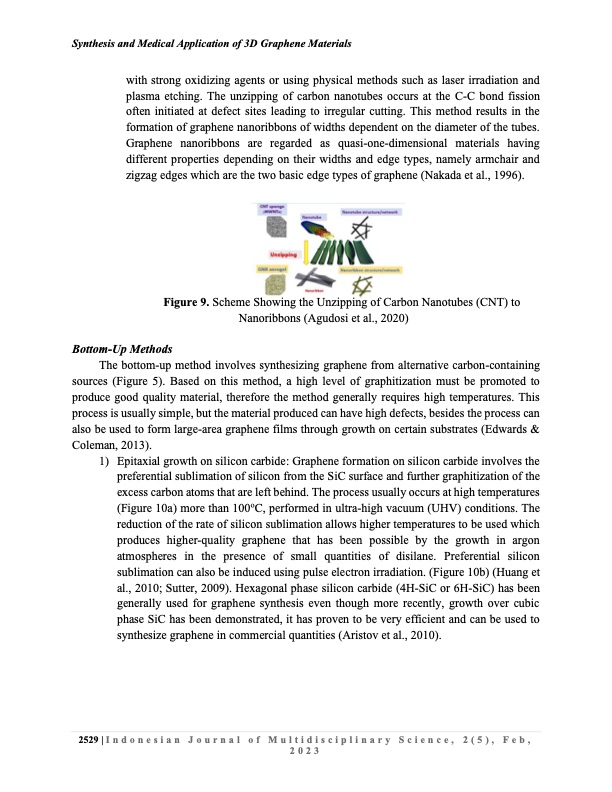
PDF Publication Title:
Text from PDF Page: 010
Synthesis and Medical Application of 3D Graphene Materials with strong oxidizing agents or using physical methods such as laser irradiation and plasma etching. The unzipping of carbon nanotubes occurs at the C-C bond fission often initiated at defect sites leading to irregular cutting. This method results in the formation of graphene nanoribbons of widths dependent on the diameter of the tubes. Graphene nanoribbons are regarded as quasi-one-dimensional materials having different properties depending on their widths and edge types, namely armchair and zigzag edges which are the two basic edge types of graphene (Nakada et al., 1996). Figure 9. Scheme Showing the Unzipping of Carbon Nanotubes (CNT) to Nanoribbons (Agudosi et al., 2020) Bottom-Up Methods The bottom-up method involves synthesizing graphene from alternative carbon-containing sources (Figure 5). Based on this method, a high level of graphitization must be promoted to produce good quality material, therefore the method generally requires high temperatures. This process is usually simple, but the material produced can have high defects, besides the process can also be used to form large-area graphene films through growth on certain substrates (Edwards & Coleman, 2013). 1) Epitaxial growth on silicon carbide: Graphene formation on silicon carbide involves the preferential sublimation of silicon from the SiC surface and further graphitization of the excess carbon atoms that are left behind. The process usually occurs at high temperatures (Figure 10a) more than 100oC, performed in ultra-high vacuum (UHV) conditions. The reduction of the rate of silicon sublimation allows higher temperatures to be used which produces higher-quality graphene that has been possible by the growth in argon atmospheres in the presence of small quantities of disilane. Preferential silicon sublimation can also be induced using pulse electron irradiation. (Figure 10b) (Huang et al., 2010; Sutter, 2009). Hexagonal phase silicon carbide (4H-SiC or 6H-SiC) has been generally used for graphene synthesis even though more recently, growth over cubic phase SiC has been demonstrated, it has proven to be very efficient and can be used to synthesize graphene in commercial quantities (Aristov et al., 2010). 2529|Indonesian Journal of Multidisciplinary Science, 2(5), Feb, 2023PDF Image | Medical Application of 3D Graphene

PDF Search Title:
Medical Application of 3D GrapheneOriginal File Name Searched:
SYNTHESIS-MEDICAL-APP-3D-GRAPHENE.pdfDIY PDF Search: Google It | Yahoo | Bing
Salgenx Redox Flow Battery Technology: Power up your energy storage game with Salgenx Salt Water Battery. With its advanced technology, the flow battery provides reliable, scalable, and sustainable energy storage for utility-scale projects. Upgrade to a Salgenx flow battery today and take control of your energy future.
| CONTACT TEL: 608-238-6001 Email: greg@infinityturbine.com | RSS | AMP |